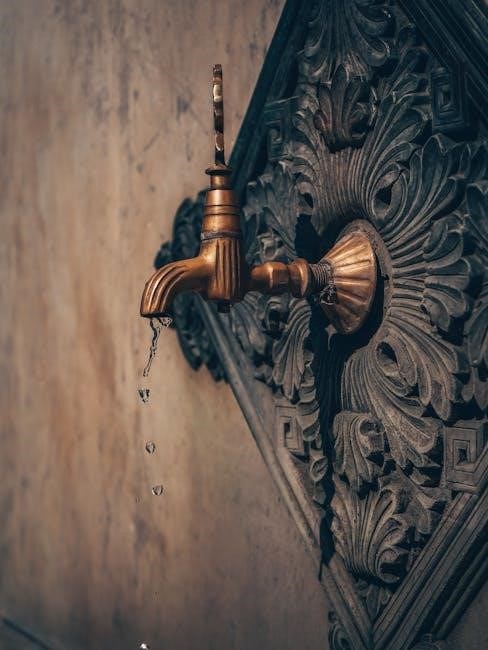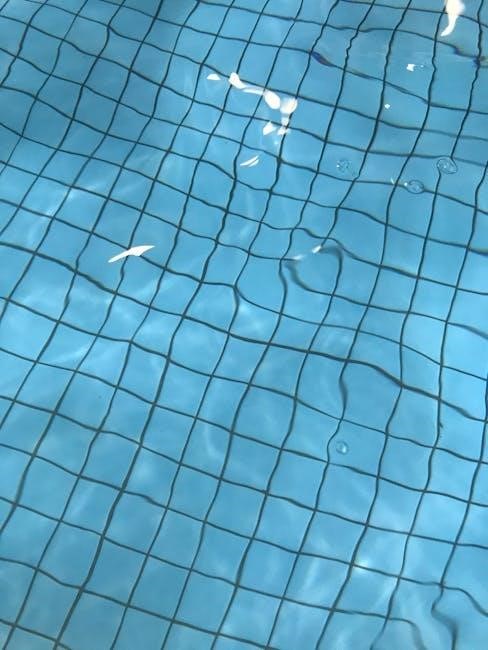
Filter elements are core components designed to trap contaminants‚ ensuring clean fluid flow in hydraulic‚ lubrication‚ and industrial systems. They are essential for maintaining system efficiency and longevity by removing particulate matter and impurities‚ thus preventing damage and downtime. Available in various types‚ they cater to different applications‚ from industrial processes to water treatment‚ making them indispensable in modern filtration technology.
1.1 Definition and Purpose
A filter element is a core component within a filter designed to trap contaminants and impurities‚ ensuring clean fluid flow. Its primary purpose is to protect systems by removing particulate matter‚ preventing damage and maintaining efficiency. Commonly used in hydraulic‚ lubrication‚ and industrial systems‚ filter elements play a crucial role in safeguarding equipment and extending operational lifespan.
1.2 Importance in Filtration Systems
Filter elements are vital for maintaining system performance and longevity. They prevent contamination‚ reduce wear on components‚ and ensure fluid quality‚ which is critical in industrial‚ hydraulic‚ and lubrication systems. By removing impurities‚ filter elements minimize downtime‚ enhance operational efficiency‚ and protect equipment from damage‚ making them indispensable in modern filtration technology and system reliability.
Types of Filter Elements
Filter elements are categorized into hydraulic‚ vacuum‚ and coalescing types‚ each designed for specific applications. Hydraulic filters handle high-pressure fluids‚ while vacuum filters capture dust particles. Coalescing filters separate liquids from gases‚ ensuring efficient contamination control across various industrial and system requirements.
2;1 Hydraulic Filter Elements
Hydraulic filter elements are designed to handle high-pressure fluids‚ removing contaminants and particulate matter to protect system components. Constructed from materials like glass fiber or metal‚ they ensure optimal performance and longevity. These elements are crucial in hydraulic systems‚ where cleanliness is paramount to prevent damage and maintain operational efficiency.
2.2 Vacuum Filter Elements
Vacuum filter elements are designed to remove dust and small particles from vacuum flows‚ preventing pump breakdowns and ensuring smooth operation. Typically made from materials like borosilicate glass microfiber‚ they are ideal for cleanroom applications and sensitive systems. These elements are replaceable‚ offering durability and efficiency in maintaining vacuum system performance and reliability.
2.3 Coalescing Filter Elements
Coalescing filter elements combine multiple layers of media to separate and remove liquids from gases or vapors. Constructed from materials like borosilicate glass microfiber‚ they are fully disposable and designed for high-efficiency filtration. These elements are commonly used in applications requiring precise separation‚ ensuring optimal performance in industrial and cleanroom environments by preventing contamination and maintaining system integrity.

Key Characteristics of Filter Elements
Key characteristics include filtration media‚ retention capacity‚ dirt holding capacity‚ and pressure loss. These elements ensure optimal performance by effectively capturing contaminants and maintaining fluid flow efficiency.
3.1 Filtration Media
Filtration media are crucial in determining a filter element’s efficiency. Common materials include glass fiber‚ filter paper‚ and wire mesh‚ each offering unique particle retention capabilities. The media’s porosity and thickness influence the balance between flow rate and contaminant capture‚ ensuring optimal performance in various industrial applications.
3.2 Retention Capacity
Retention capacity refers to a filter element’s ability to capture and hold contaminants without compromising flow. Higher capacity media retain more particles‚ reducing maintenance and extending service life. Proper material selection ensures optimal performance‚ balancing efficiency and pressure loss‚ while preventing premature clogging in hydraulic and lubrication systems.
3.3 Dirt Holding Capacity
Dirt holding capacity measures how much contaminant a filter element can capture before requiring replacement. Higher capacity extends service intervals and reduces downtime. Designed to handle varying contaminant loads‚ it ensures system efficiency and reliability‚ preventing premature clogging and maintaining flow rates in hydraulic and industrial applications.
Installation and Maintenance
Proper installation involves unscrewing‚ removing the cover‚ and replacing the old filter element with a new one. Regular cleaning of the housing and ensuring a proper fit are essential. Maintenance includes monitoring pressure changes and replacing elements when the differential pressure reaches 1.5 bar‚ ensuring optimal system performance and longevity.
4.1 Step-by-Step Installation Guide
Step 1: Unscrew and remove the filter housing cover to access the filter element. Step 2: Carefully pull out the old filter element and discard it. Step 3: Clean the housing thoroughly to ensure no residue remains. Step 4: Insert the new filter element‚ ensuring it is properly seated. Step 5: Reattach the cover and tighten the screws securely. This ensures a leak-free and efficient filtration process.
4.2 Cleaning vs. Replacing the Filter Element
Cleaning the filter element can extend its lifespan‚ but not all elements are reusable. For particulate filters‚ cleaning is often sufficient‚ while coalescing filters usually require replacement. Manufacturers recommend replacing the element when the differential pressure reaches a specified threshold‚ typically 1.5 bar‚ to maintain optimal performance and prevent system damage.
4.3 Troubleshooting Common Issues
Common issues with filter elements include increased pressure drop‚ contamination‚ and system stoppages. High differential pressure indicates a clogged element‚ requiring cleaning or replacement. Regular monitoring and adherence to manufacturer guidelines prevent premature failure. Addressing these issues promptly ensures optimal system performance and avoids operational disruptions. Proper maintenance extends filter lifespan and system reliability.
Performance and Technical Specifications
Filter elements are designed to meet specific performance metrics‚ including pressure loss‚ flow rate‚ and retention capacity. Technical specs ensure compatibility with system requirements and durability.
5.1 Pressure Loss and Flow Rate
Pressure loss and flow rate are critical factors in filter element performance. A well-designed filter minimizes pressure drop while maintaining optimal flow‚ ensuring system efficiency. The filter media and housing design play key roles in balancing these parameters to meet specific application demands‚ ensuring reliable operation without compromising filtration efficiency or system performance.
5.2 Compatibility with System Requirements
Compatibility with system requirements ensures filter elements function seamlessly within existing setups. They must align with fluid types‚ flow rates‚ and pressure ranges to maintain performance. Proper material selection and design enable them to handle specific substances‚ from oils to water‚ while adhering to technical specifications. Compatibility is verified through testing to guarantee reliable operation across various applications.
5.3 Operating Temperature and Durability
Filter elements are designed to withstand a wide range of operating temperatures‚ ensuring reliable performance in extreme conditions. Their durability is enhanced by high-quality materials and robust constructions‚ allowing them to endure thermal fluctuations and maintain structural integrity. Proper material selection ensures compatibility with specific applications‚ while advanced designs maximize lifespan and minimize maintenance needs over time.

Applications of Filter Elements
Filter elements are widely used in industrial hydraulic systems‚ vacuum pumps‚ water treatment‚ and lubrication systems. They protect equipment‚ ensure fluid purity‚ and maintain operational efficiency across diverse industries.
6.1 Industrial Hydraulic Systems
Filter elements are crucial in industrial hydraulic systems‚ protecting components from contamination and ensuring fluid purity. They prevent damage from particulate matter‚ maintaining system efficiency and longevity. Capable of filtering down to 25 μm‚ these elements are designed to handle high-pressure and temperature conditions‚ making them essential for reliable operation in demanding hydraulic applications.
6.2 Vacuum Pumps and Cleanrooms
Filter elements in vacuum pumps and cleanrooms are designed to remove dust and small particles from airflow‚ preventing pump breakdowns. Coalescing filters are used to separate liquids from gases‚ ensuring high purity in sensitive environments. Disposable designs simplify maintenance‚ while electrostatic protection enhances performance in cleanroom settings‚ maintaining contamination-free conditions for critical applications.
6.3 Water Treatment and Lubrication Systems
Filter elements play a vital role in water treatment by removing impurities and contaminants‚ ensuring clean water output. In lubrication systems‚ they protect equipment by filtering out dirt and debris‚ preventing wear and tear. High-efficiency filters with precise micron ratings are often used to maintain fluid cleanliness‚ ensuring optimal performance and prolonging system lifespan in both applications.
Manufacturer Guidelines and Warranty
Manufacturers provide specific guidelines for filter element installation and maintenance to ensure optimal performance. Warranties typically cover defects for a specified period‚ ensuring reliability and customer satisfaction.
7.1 Manufacturer Recommendations
Manufacturers recommend adhering to installation and maintenance guidelines to ensure optimal filter element performance. Proper sizing‚ alignment‚ and material compatibility are crucial. Regular inspections and replacements‚ as specified‚ prevent system downtime. Using genuine parts and following torque specifications are emphasized to maintain warranty validity and ensure reliability across hydraulic‚ lubrication‚ and industrial applications.
7.2 Warranty and Replacement Policies
Manufacturers typically offer a 12-month warranty for filter elements‚ ensuring defect-free performance. Replacement policies vary‚ often requiring proof of purchase and adherence to installation guidelines. Proper disposal methods are recommended to comply with environmental regulations‚ ensuring safe handling of used filter elements and maintaining system integrity throughout their lifecycle.

Advanced Features in Modern Filter Elements
Modern filter elements incorporate innovative features like electrostatic discharge protection‚ high-temperature resistance‚ and modular designs. These advancements enhance durability‚ efficiency‚ and adaptability‚ addressing diverse industrial needs effectively while ensuring optimal performance and longevity.
8.1 Electrostatic Discharge Protection
Electrostatic discharge (ESD) protection in filter elements prevents damage from static electricity‚ ensuring safe operation in sensitive systems. Advanced materials and designs neutralize charges‚ reducing risks of sparks and component failure. This feature is crucial for applications in explosive environments or systems requiring high reliability‚ making modern filter elements more robust and reliable than ever.
8.2 High-Temperature Resistance
8.3 Modular and Disposable Designs
Modern filter elements feature modular and disposable designs‚ offering convenience and ease of maintenance. These designs allow for quick replacement without tools‚ reducing downtime. Made from materials like borosilicate glass microfiber‚ they provide high performance and adaptability. Modular designs enable customization‚ while disposable elements simplify waste management‚ making them ideal for systems requiring frequent filter changes and high efficiency.

Filter Element Replacement and Disposal
Filter elements should be replaced when a differential pressure of 1.5 bar is reached. Proper disposal methods ensure environmental safety. Always use compatible elements to prevent contamination and maintain system efficiency. Regular replacement and eco-friendly disposal practices are crucial for optimal performance and longevity of filtration systems.
9.1 When to Replace the Filter Element
Replace the filter element when a differential pressure of 1.5 bar is reached‚ as indicated by pressure gauges. Visual inspections for dirt buildup or damage are also crucial. Regular monitoring ensures optimal system performance and prevents contamination.
Manufacturer guidelines recommend replacement intervals based on operating conditions. Timely replacement prevents system breakdowns and maintains fluid cleanliness. Always use compatible filter elements to ensure proper functionality and longevity of the filtration system.
9.2 Proper Disposal Methods
Dispose of filter elements according to environmental regulations and manufacturer guidelines. Contaminated elements may require special handling to prevent hazardous material release. Separate recyclable materials like metal end caps from filter media. Proper disposal ensures environmental safety and compliance with local waste management laws. Always follow specific instructions for hazardous waste disposal if applicable.
Case Studies and Real-World Applications
Filter elements are widely used in industrial filtration‚ water treatment‚ and lubrication systems. Real-world applications include manufacturing‚ power plants‚ and aerospace‚ ensuring optimal performance and contamination control across diverse industries.
10.1 Success Stories in Industrial Filtration
Filter elements have proven critical in industrial filtration‚ with success stories from manufacturers like Eaton and MP Filtris. These elements have enhanced hydraulic systems‚ water treatment plants‚ and aerospace applications‚ reducing downtime and maintenance costs while ensuring optimal performance and contamination control across diverse industries.
10.2 Overcoming Challenges in Filtration Systems
Filter elements have addressed challenges like high dirt loads and pressure loss in industrial systems. Advanced designs‚ such as coalescing elements and electrostatic discharge protection‚ mitigate contamination risks. These innovations ensure reliable operation in sensitive applications‚ from hydraulic systems to cleanrooms‚ enhancing overall system performance and longevity while reducing maintenance and downtime significantly.
Future Trends in Filter Element Technology
Future trends include advancements in nanotechnology‚ smart materials‚ and IoT integration‚ enabling real-time monitoring and predictive maintenance for enhanced efficiency and system optimization.
11.1 Innovations in Filtration Media
Innovations in filtration media include advanced nanofiber materials‚ activated carbon‚ and antimicrobial coatings‚ enhancing contaminant removal efficiency. These developments improve filtration accuracy‚ durability‚ and sustainability‚ meeting stringent industrial and environmental standards while reducing maintenance needs.
11.2 Smart Filters and IoT Integration
Smart filters integrated with IoT technology enable real-time monitoring and predictive maintenance. Sensors embedded in filter elements detect contamination levels and notify users when replacement is needed. IoT connectivity allows remote monitoring‚ reducing downtime and optimizing performance. Advanced algorithms analyze data to predict failures‚ ensuring seamless operation. This integration enhances efficiency‚ reduces costs‚ and improves reliability in industrial systems.
Filter elements are crucial for system efficiency‚ offering various types for different applications. Proper maintenance and advancements ensure optimal performance and longevity universally.
12.1 Summary of Key Points
Filter elements are essential for ensuring system efficiency and reliability. They play a critical role in contamination control and maintaining fluid purity. Available in various types‚ they cater to different applications‚ from industrial to water treatment. Proper selection and maintenance are vital for optimal performance‚ making them indispensable in modern filtration systems.
12.2 Best Practices for Filter Element Usage
Regular maintenance and timely replacement of filter elements ensure optimal performance. Monitor pressure loss and replace elements when recommended. Choose elements compatible with system requirements to avoid contamination. Follow manufacturer guidelines for installation and cleaning. Proper disposal of used elements prevents environmental harm. Always select high-quality materials for durability and efficiency in filtration processes.